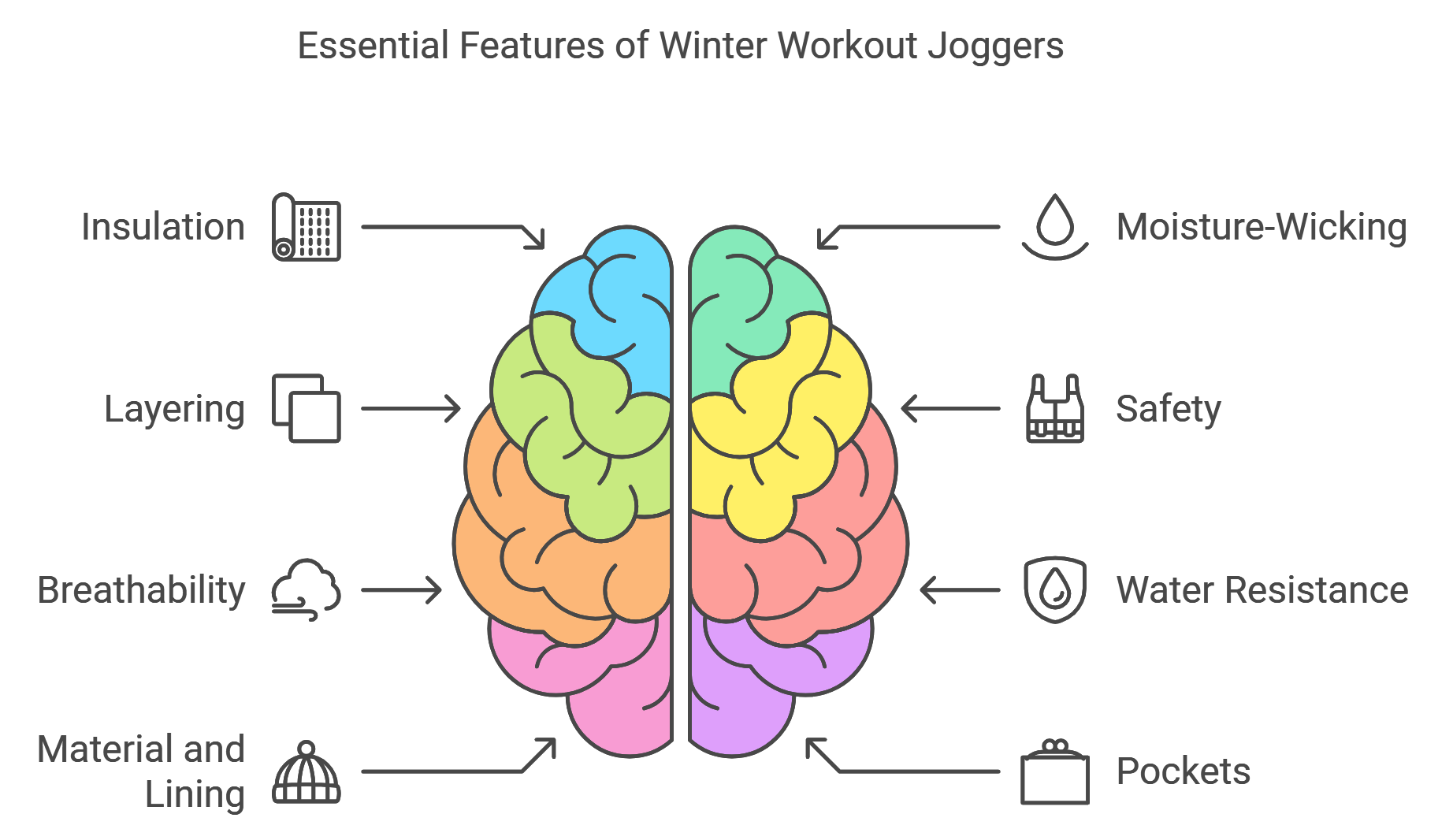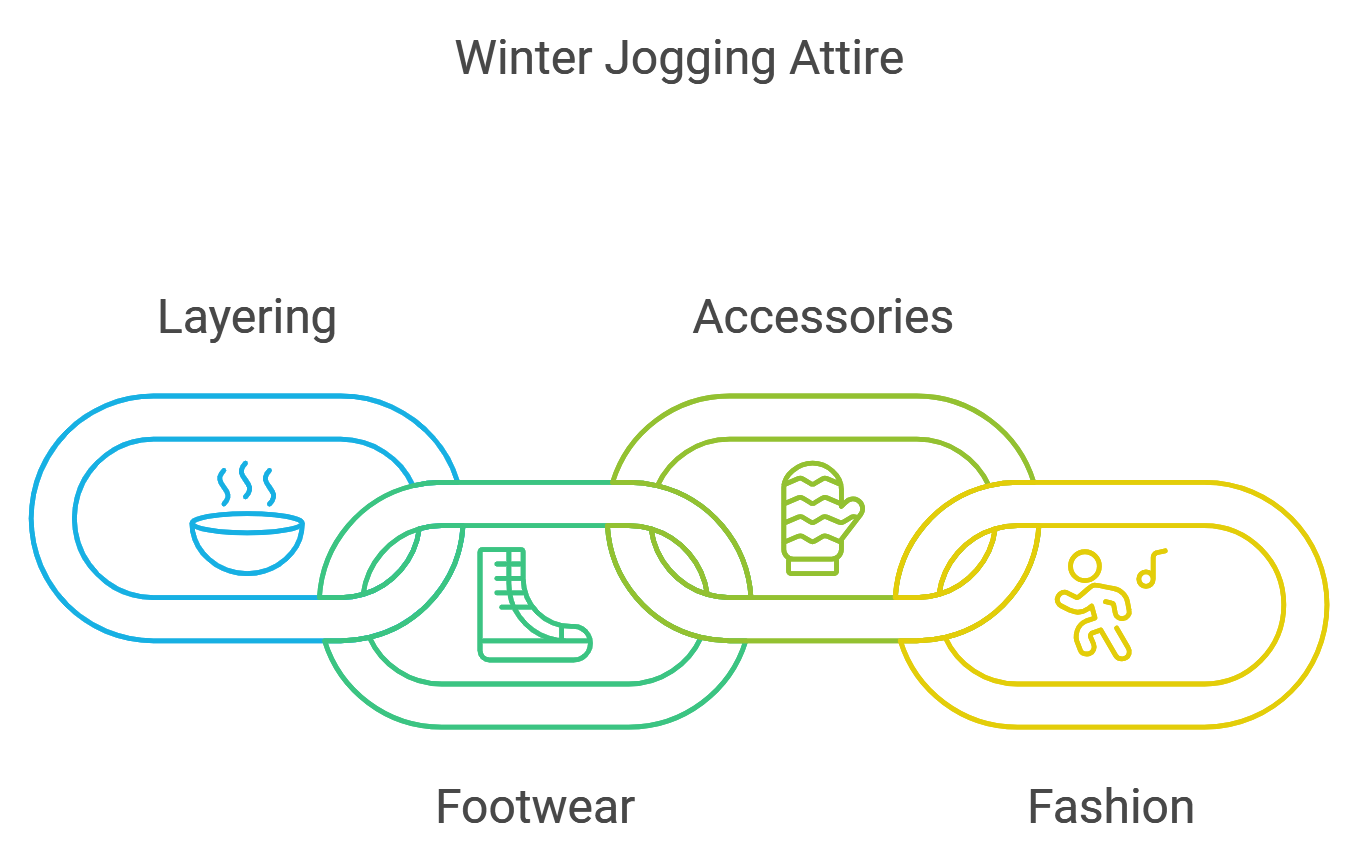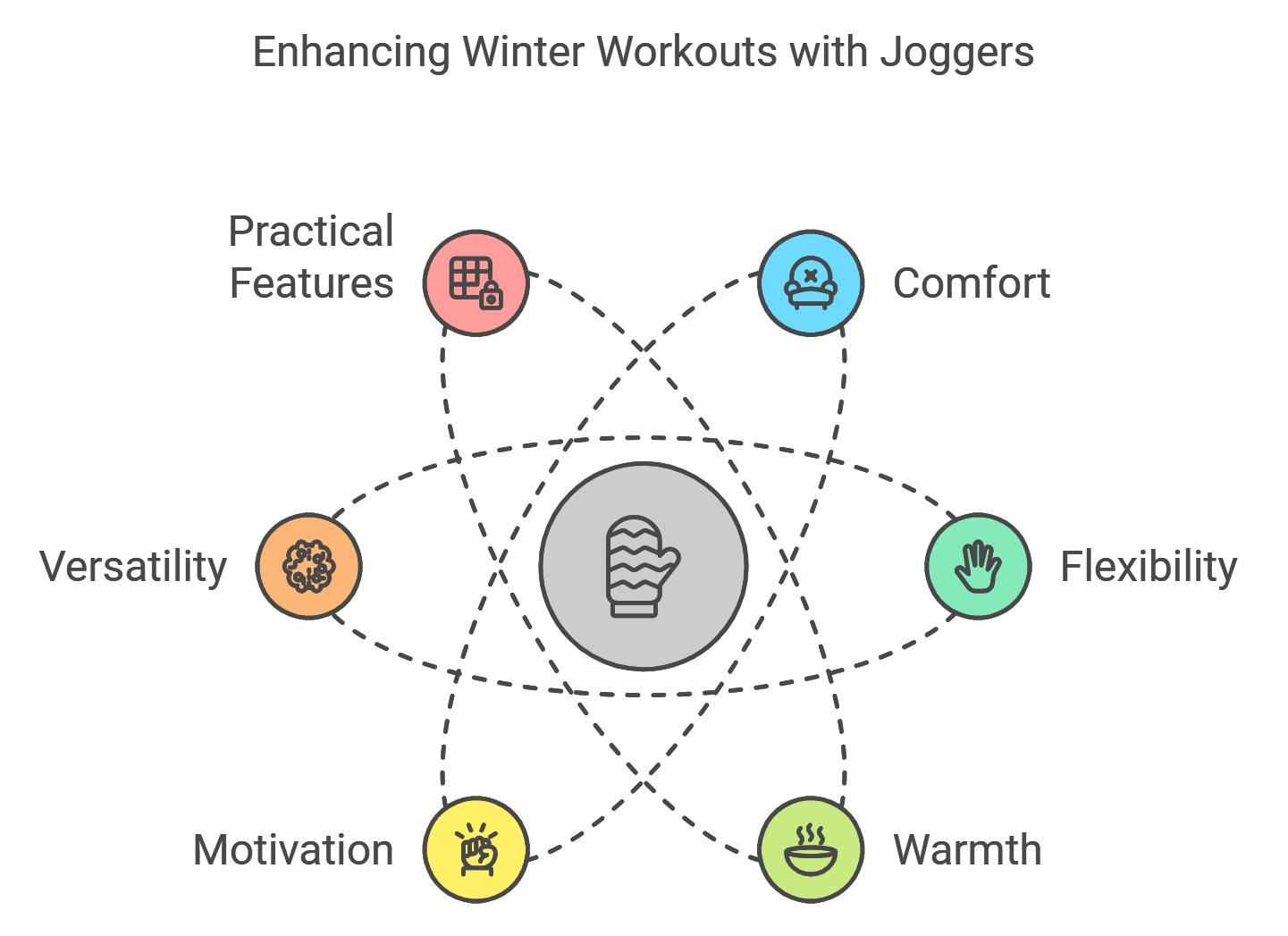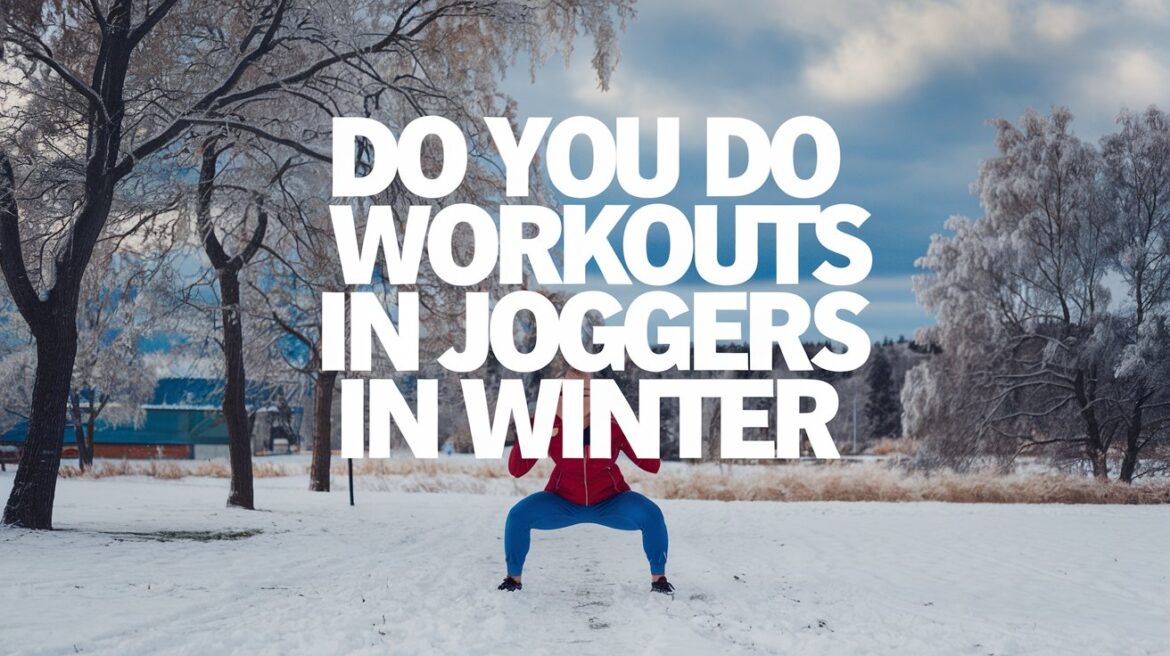INTRO
Winter workouts could be tough. The cold weather does tempt you to skip that routine exercise, but there’s something else that may just make a difference-the right gear.
In this regard, joggers can be of great importance. They’re not really designed for lounging but could be excellent for working out in winter.
Joggers are so warm and cozy; they are the perfect comfort for cold weather workouts. A good pair helps one maintain a workout regimen despite the dropping temperatures.
But not all joggers are the same.
In this article, we are going to discuss the benefits of wearing joggers during winter workout sessions. We will also guide you on how to pick the right pair for your workout needs.
So, are you ready to start working out in the winters with the right joggers? Let’s get started.
Benefits of Choosing Joggers for Winter Workouts
Joggers are great at keeping you warm during winter workouts. They let your body’s warmth stay in it and move freely. As such, they are clever to warm up even when exercising in extremely freezing temperatures.
Moisture-wicking joggers will keep sweat off your body. The characteristic, therefore, prevents your sweat from showing on your skin. Keep sweating; do not stay wet, cold, or uncomfortable.
Layering is very necessary in winter time, and joggers can easily be used as a base layer. They can be teamed up with the thermal layers to have an increase in warmth. Their flexibility makes them so easy to layer up.
Safety is another thing during workouts in winter time. The joggers with reflective details can increase their visibility during such low-light conditions. Moreover, the right fit is one other important thing since it minimizes the possibility of tripping over.
Any workout needs breathability and temperature control. Joggers allow ventilation so you do not overheat. It keeps you cool and comfortable when working hard.
lastly, water-resistant joggers may protect you from snow or rain. It keeps you dry in wet winter conditions. On top of that, protection gives you a chance to focus on your fitness routine.
These features might make your joggers very great for you to use for winter workouts. Stay safe, comfortable, and motivated with the right joggers.
Right joggers for working out during winter depend on some key features. Material and lining should be part of keeping warm. Find joggers that have a fleece lining or are made of thermal material to help keep you warm even on cold days.
You’d think you wouldn’t miss the pockets but then, it is absolutely necessary to be a jogger. They come quite in handy as a key holder or a phone holder with suitable safety and practicality for using zippered rather than pocketed jogging clothes.
Elastic cuff along with high waist ones. The elastic cuffs provide the warmth of a thermal trap. It keeps warm by shutting out the cold air. Meanwhile, it allows warmth to seep into through your body. Similarly, a high waist one would give extra covering down below which contributes to keeping the core warm as well.

Technical fabrics over cotton may greatly affect performance
Technical fabrics will handle moisture and thermal regulation better than cotton. They also dry quickly and feel comfortable against the skin.
Do not forget to highlight reflective details. Joggers with reflective strips enhance safety in early morning or evening workouts. Visibility is crucial during the shorter daylight hours of winter.
When you choose your workout joggers, keep an eye out for these essential factors to provide you the best comfort and functionality to achieve your exercise goals in the winter season.
Let’s take a quick review:
Insulating material and lining
Pockets safely closed
Elastic cuff and high waist
Technically over cotton fabric material
Reflective safety aspects
Consider all these while choosing your jogging, then you are fully prepared with your winter workouts to continue your exercise regimes in a comfortable and enjoyable way.
Joggers Winter Exercise routines
While dressing for joggers in winter, layering is important. Thermal compression layers can add warmth without bulk. Base layers that fit well along with breathable tops can really make a difference during the workout.
Footwear that is right equals clothing. Jogging shoes with appropriate insulation and grip are best. Your feet will not only be warm but safe. Waterproof options would be beneficial if you’re exercising outside in wet or snowy weather.
Accessorize to add functionality and comfort. You can get extra protection from the cold by wearing gloves, hats, and neck warmers. These accessories make sure you are warm while, at the same time, can add a personal touch to your outfit.
Get joggers that fashion you. Get joggers that put you in the colors or patterns that will make you feel more confident. Design-styles can make for some really great and highly-functional jogging, thus making one exercise even more during the winter months.

How to Care Your Joggers: Tips on Longevity
Proper care will also prolong the life of joggers. You can clean them in cold water as this prevents fabric and color deterioration. Be wary of harsh detergents. Always refer to the label for special instructions.
The proper drying of joggers prevents damage and shrinkage. In fact, it is usually better to dry joggers out in the air as heat from the dryer is so strong it can break the fibers apart. If you must dry them in the dryer, use the lowest heat available.
Keep your joggers in a clean, dry place. Do not stuff them into small areas because this can cause wrinkles and misshaping. Inspect for tears and repair minor tears in time to keep them usable.
The jogger style depends on the workout and setting. Indoor activities can afford lighter, breathable fabrics. Outdoor activities require joggers with extra insulation and weather resistance.
Environmental conditions also determine joggers. Cold, wind, and rain will influence features such as water resistance or wind proofing. Reflective details are useful in low-light conditions common during winter.
In extreme cold, the combination of joggers and layers with thermal underlayers would do. It would help to keep the heat locked and does not affect mobility. In extreme weather conditions, you could wear windproof pants layered over joggers.
Joggers are versatile and applicable both indoors and outdoors. You can easily switch gears from indoors to outdoors with them. So, joggers must be part of every workout wardrobe. With suitable joggers that allow wide varieties of activities, you are guaranteed comfort and efficiency while exercising.

The Psychological and Physical Benefits of Working Out in Joggers During Winters
The comfort and confidence that wearing joggers can bring about can improve your winter workout. You feel cozy as you go about exercising. This will improve your mindset, and you are likely to continue with your routine.
Proper dressing can help ward off muscle pull and tear, especially in cold climates. Joggers are of utmost importance for warmth keeping the muscles limbered. This reduces the prospect of pulling or straining the muscles during exercise.
Joggers make folks stick to their exercise routines owing to the flexibility they provide in movement.
They are meant for a wide range of activities and weather conditions too, from running to yogas. This versatility can prompt regular physical activity whether it is hot or snowing outside.
Motivation is key, and what you wear could help. A good-fitting fashionable jogger can motivate you to move more.
When you like your clothes, you are likely to work out. This helps you keep your fitness goals over the winter.
Joggers are a very vital part of winter exercises as they are comfortable with functionality. They provide warmth, flexibility, and support to an individual, which is necessary for exercising in the cold season.
When selecting joggers, ensure that you choose materials that will keep you warm but also allow air circulation.
Consider having features like pockets and reflective details to enhance practicality and safety. A good fit helps to maximize comfort and performance.
Keeping active during winter months helps your body and mind immensely.
You will be jogging with the right joggers all year long. When temperatures have dipped, joggers will encourage you even more. Go for exercise in winter and keep rolling!

Some Comfort and Safety Tips When Exercising in Winter
Safety in Low Light Conditions: Reflective Joggers and Visibility
Low visibility is the biggest issue that one encounters while exercising in the winter months. Daylight hours have drastically cut down. In case of exercising at very early morning time or late in the evening, opt for joggers with reflective material.
Visible to pedestrians, cyclists and drivers, these can save you from injuries or fatalities resulting from being overlooked or hit by any one of the above three parties, simply because they can’t catch a glimpse of you by the poor illumination in dark.
Also, with reflective outerwear and accessories like hats or vests, you will feel even safer, thus safe during winter workouts.
Safety in Low-Light Conditions: Reflective Joggers and Visibility
Footwear Compatibility: How to Pair Joggers with Winter Workout Shoes
The choice of the right footwear that complements joggers is one that has a direct impact on the performance and comfort during the workout. Find shoes with thermal insulation, good grip resistance, and adequate support because you are likely to get wet while jogging or strolling on damp and moist surfaces.
Additionally, such shoes should not make much noise as they may become slippery on ice surfaces as well. In addition to joggers, appropriate gear would complete the winter exercise outfit while keeping you active yet in safety.
Breathability and Ventilation: A Question of Balancing Heat with Moisture Control
Although it is critical to warm up during the winter period, it is also extremely vital to not overheat or sweat a lot, especially when you are physically working out.
Therefore, consider joggers that comprise breathable, moisture-wicking materials that make sure quick evaporation of sweat through keeping the skin dry, feeling comfortable, and non-chafing.
Air circulation is increased through joggers with ventilated panels or moisture management technology to help you stay comfortable by preventing overheating and sweats during workouts. It means you’ll not need to stop yourself in front of those harsh cold and wind because of your condition but push on and tackle it.
Breathability and Ventilation
Finding the Trade-Off between Warmth and Moisture Management
Important additions in this section will make your article more informative by discussing how to comfortably and safely train during winter in joggers. Would you like me to help you with the rest of your content?
FAQs
Does jogger wear sufficiently keep one warm enough even in sub-zero temperatures?
Winter joggers may be available with insulation or linings that maintain warmth, though to beat sub zero conditions, the joggers used need to have a thermal property besides layering up correctly. Thermal leggings or long johns can also be worn under joggers for additional warmth.
Joggers can be surely utilized in high-intensity activities in winter?
Yes, joggers can perfectly be used for intense and heavy winter workouts. Find joggers made of a moisture-wicking and airy material. Joggers need to have stretchable clothing to allow you full exercising movements. Ventilation-feature joggers will help out in regulating your body’s temperature during intense exercises or activities.
What layers wear under joggers to better keep warm?
For extra warmth, you can wear thermal leggings or base layers of moisture-wicking material under your joggers. Fleece-lined tights or compression layers can also keep you warm without adding bulk. Base layers should fit snugly so you can maintain your comfort and flexibility during workout.
How do joggers compare to leggings for winter activities?
Joggers tend to fit looser than leggings, and they offer better breathability and comfort for many users. Joggers also may include extra details, such as pockets and elastic cuffs. However, the leggings are generally made from thicker and more compressive materials, which can make them warmer and provide greater support. It’s up to you to decide.
Are there specific materials to avoid in winter workout joggers?
Yes, the top materials to avoid using in winter workout joggers are cotton. Cotton absorbs moisture leading to you chill and feel uncomfortable with cold weather situations.
Instead, synthetic materials such as polyester, nylon, or blends that offer good moisture-wicking characteristics, breathability, and some insulation will keep the body warm and dry while exercising.
Of course, I encourage you to include more details or clarify other aspects of your article if you feel the need for it.

